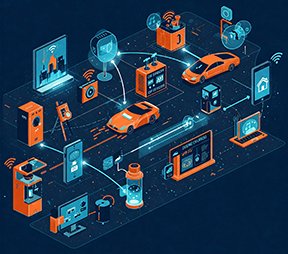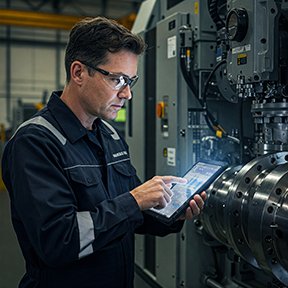Published: December 18, 2015 | Updated: September 23, 2025
Published: December 18, 2015 | Updated: September 23, 2025
The Expanding Universe of Internet-Connected Things
 The Internet of Things has moved from a futuristic concept to a present-day reality, weaving its way into the fabric of our daily lives. While the term itself might still conjure images of complex networks, its essence boils down to a simple yet powerful idea: everyday objects gaining the ability to connect and communicate. This connectivity opens up a world of possibilities, transforming how we interact with the devices around us and the environments we inhabit. Let's look at the expanding universe of internet-connected things.
The Internet of Things has moved from a futuristic concept to a present-day reality, weaving its way into the fabric of our daily lives. While the term itself might still conjure images of complex networks, its essence boils down to a simple yet powerful idea: everyday objects gaining the ability to connect and communicate. This connectivity opens up a world of possibilities, transforming how we interact with the devices around us and the environments we inhabit. Let's look at the expanding universe of internet-connected things.
Decoding the Internet of Things
At its core, the Internet of Things describes a network of physical objects embedded with sensors, software, and other technologies that enable them to collect and exchange data. This allows devices to interact with each other, with users, and with the broader internet infrastructure. Think of it as extending the internet's reach beyond computers and smartphones to encompass a vast array of items, granting them a digital voice and the ability to participate in the interconnected world. This simple concept fuels a revolution across various sectors, from homes to industries.
Smart Homes: Where Connectivity Meets Convenience
One of the most visible manifestations of the IoT appears in the realm of smart home technology. This area focuses on equipping household devices and systems with internet connectivity for enhanced control and automation. Consider the convenience of managing your home's lighting remotely. Instead of fumbling for switches in the dark, you can use a smartphone app to illuminate your porch lights as you approach.
Similarly, smart security systems offer peace of mind by allowing you to monitor and manage your home's defenses from anywhere. You can arm or disarm alarms, receive alerts for unusual activity, and even view live video feeds, all through your connected devices. This level of control and accessibility redefines how we interact with our living spaces.
Beyond Lights and Locks
The smart home ecosystem extends far beyond basic lighting and security. Thermostats learn your preferences and adjust temperatures automatically, contributing to energy savings and comfort. Smart refrigerators can track your groceries, alert you when supplies run low, and even suggest recipes based on available ingredients. Entertainment systems seamlessly integrate streaming services and voice control, creating immersive and personalized experiences. Even seemingly mundane tasks like watering plants or feeding pets can become automated through connected devices, freeing up time and adding a layer of convenience to daily routines.
Unexpected Connections: The Quirky Side of IoT
While many IoT devices serve practical purposes, the landscape also includes some truly unique and sometimes unconventional creations. The My Satis smart toilet exemplifies this. For a significant investment, owners gain the ability to control various functions, such as flushing, lid operation, and bidet settings, through a smartphone application. While the immediate utility might seem niche, it highlights the imaginative possibilities that arise when everyday objects gain network capabilities. Perhaps for individuals with specific hygiene concerns or accessibility needs, such a device presents genuine value.
Discover how streamlined maintenance processes can elevate production. Learn more.
Wearable Tech: Connecting Our Bodies
Another fascinating category within the IoT is wearable technology. Ralph Lauren's Polo Tech Shirt demonstrates how connectivity integrates directly into our clothing. By embedding sensors into the fabric, the shirt monitors a range of biometric data during physical activity, including heart rate, breathing patterns, step count, and calorie expenditure. This data provides valuable insights for fitness enthusiasts and athletes looking to track their performance and understand their bodies better.
Beyond fitness, wearable devices like smartwatches and health trackers have become commonplace, offering features such as activity monitoring, sleep analysis, and even medical alerts. These devices empower individuals to take a more active role in managing their health and well-being.
Expanding the IoT Universe: More Connected Products
The examples discussed so far merely scratch the surface of the vast and expanding IoT ecosystem. Consider smart kitchen appliances beyond toasters and refrigerators. Ovens can now connect to the internet, allowing for remote preheating, recipe downloads, and even monitoring cooking progress through smartphone apps. Coffee makers can learn your preferred brewing time and strength, ensuring a perfect cup awaits you each morning. Even smaller kitchen gadgets like scales and blenders are gaining connectivity, offering precise measurements and guided recipes.
Beyond the Home: Industrial and Agricultural IoT
The impact of the IoT extends far beyond the consumer market. Industrial IoT (IIoT) involves connecting machinery, sensors, and control systems in manufacturing and other industrial environments. This connectivity enables real-time monitoring of equipment performance, predictive maintenance to prevent costly downtime, and improved operational efficiency.
In agriculture, smart sensors deployed in fields can collect data on soil conditions, weather patterns, and crop health, allowing farmers to make data-driven decisions regarding irrigation, fertilization, and pest control. This precision agriculture leads to increased yields and reduced resource consumption. Smart cities leverage IoT technologies for applications like intelligent traffic management, waste collection, and energy distribution, aiming to improve the quality of life for urban populations.
Connected Vehicles: The Future of Transportation
The automotive industry represents another significant area of IoT innovation. Modern vehicles increasingly feature embedded connectivity, enabling features like navigation, infotainment, and over-the-air software updates. Connected cars can communicate with each other and with infrastructure, paving the way for advancements in safety and autonomous driving technologies. Fleet management systems utilize IoT sensors to track vehicle location, fuel consumption, and driver behavior, leading to improved logistics and reduced operational costs.
 The Critical Role of CMMS in the IoT Landscape
The Critical Role of CMMS in the IoT Landscape
As the number of connected devices continues to grow, the need for effective management and maintenance becomes paramount. This is where Computerized Maintenance Management Systems (CMMS) play a crucial role in the IoT ecosystem. A CMMS is a software system that helps organizations manage their assets, schedule maintenance activities, track work orders, and manage inventory. When integrated with IoT devices, a CMMS gains access to real-time data from sensors embedded in equipment and machinery.
Predictive Maintenance and Proactive Issue Resolution
The integration of IoT data with a CMMS enables predictive maintenance. Instead of relying on fixed maintenance schedules, the system can analyze data from connected sensors to identify potential equipment failures before they occur. For example, sensors might detect unusual vibrations or temperature increases in a machine, signaling an impending issue. The CMMS can then automatically trigger an alert and the maintenance manager can easily create and dispatch a work order, allowing technicians to address the problem proactively. This shift from reactive to proactive maintenance represents a significant advantage offered by the synergy between IoT and CMMS.
Improved Asset Management and Operational Efficiency
Beyond predictive maintenance, a CMMS enhances asset management within an IoT environment. The system can track the location, status, and maintenance history of all connected devices. This provides a comprehensive overview of an organization's assets, facilitating better decision-making regarding resource allocation and equipment lifecycle management.
Furthermore, the automation of work order generation, scheduling, and tracking through the CMMS improves operational efficiency by reducing manual processes and ensuring timely maintenance interventions. The data collected by IoT devices and managed within the CMMS also provides valuable insights for identifying areas for improvement in equipment performance and overall operational workflows.
Navigating the Challenges of an Interconnected World
While the benefits of the IoT are numerous, the increasing connectivity also presents certain challenges. As highlighted with the smart toilet example, security remains a significant concern. Connected devices can become potential entry points for cyberattacks, allowing unauthorized access to personal data and control over physical systems. Therefore, strong security measures and user awareness are crucial for mitigating these risks. Data privacy also emerges as a key consideration, as IoT devices often collect vast amounts of personal information. Ensuring the responsible collection, storage, and use of this data is essential for building trust in the IoT ecosystem.
The Internet of Things continues its rapid evolution, promising even more interconnected and intelligent devices in the future. This technological frontier holds the potential to reshape industries, transform our homes, and redefine our interactions with the physical world in ways we are only beginning to imagine. The journey of connected things has just begun.
FAQs
What is the Internet of Things (IoT)?
The IoT refers to everyday objects equipped with sensors and software that enable them to connect, communicate, and exchange data over the internet.
How does IoT enhance smart homes and daily life?
IoT devices like smart thermostats, security systems, and connected appliances improve convenience, energy efficiency, and personalized control in homes.
What role does IoT play in industrial and agricultural sectors?
Industrial IoT monitors machinery and production lines for efficiency, while agricultural IoT collects data on soil and crops for precision farming and resource optimization.
How do connected vehicles benefit from IoT technology?
IoT in vehicles enables navigation, fleet tracking, predictive maintenance, and over-the-air updates, improving safety, logistics, and operational efficiency.
Why is MAPCON CMMS important in an IoT ecosystem?
Clients can leverage MAPCON CMMS for predictive maintenance and asset tracking, but integration with IoT sensors requires assistance from MAPCON’s support team.
How does combining CMMS with IoT improve maintenance strategies?
The integration allows for proactive issue detection, automated scheduling, and detailed asset management, reducing downtime and increasing productivity.
MAPCON | 800-922-4336
MAPCON CMMS software empowers you to plan and execute PM tasks flawlessly, thanks to its wealth of features and customizable options. Want to see it for yourself? Click the button below to get your FREE 30-day trial of MAPCON!
Try It FREE!